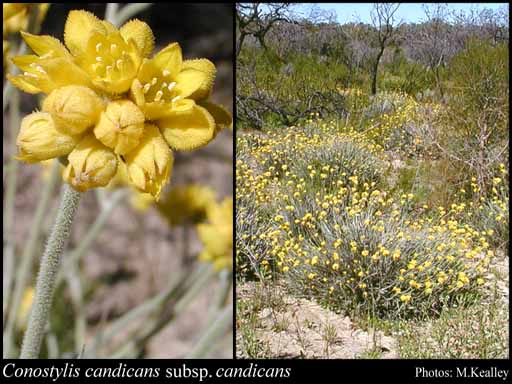- Conservation Code
- Not threatened
- Naturalised Status
- Native to Western Australia
- Name Status
- Current
Rhizomatous, tufted perennial, grass-like or herb, 0.2-0.4 m high, to 1 m wide. Fl. yellow, Jul to Nov. White, grey, yellow or red sand, limestone.

Scientific Description
Leaves flat, 80-140 mm long, 1.5-3.5 mm wide; bristles or hairs on the leaf margin absent; hairs on the surface of the leaf present. Scape present, hairy, 190-300 mm long. Inflorescence subtended by a bract 15-45 mm long, with several flowers; floral bracts 7.5-12 mm long; pedicels sessile; flowers 10-14 mm long. Perianth hairy, radially symmetrical, uniformly coloured, yellow, with six more or less equal tepals, the inner segments 4.5-6 mm long. Stamens six, in one level; filaments (1-)1.2 mm long; anther 2.5-3.2 mm long, without an appendage. Style 7.5-11 mm long. Flowers in July, August, September, October or November. Occurs in the Geraldton Sandplains, Swan Coastal Plain, Avon Wheatbelt and Jarrah Forest IBRA bioregion(s), of the South-west Botanical Province.
Distribution
- IBRA Regions
- Avon Wheatbelt, Geraldton Sandplains, Jarrah Forest, Swan Coastal Plain.
- IBRA Subregions
- Dandaragan Plateau, Geraldton Hills, Katanning, Lesueur Sandplain, Merredin, Northern Jarrah Forest, Perth.
- IMCRA Regions
- Central West Coast, Leeuwin-Naturaliste.
- Local Government Areas (LGAs)
- Armadale, Cambridge, Canning, Carnamah, Chapman Valley, Chittering, Cockburn, Coorow, Cottesloe, Dandaragan, Fremantle, Gingin, Irwin, Kalamunda, Kwinana, Mandurah, Melville, Mingenew, Moora, Mundaring, Nedlands, Northam, Perth, Rockingham, Stirling, Swan, Three Springs, Toodyay, Victoria Plains, Wanneroo.